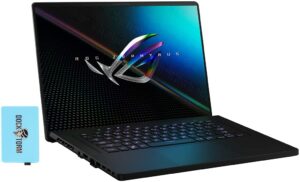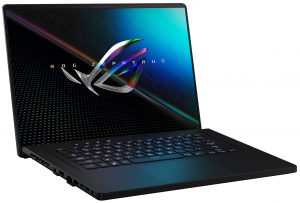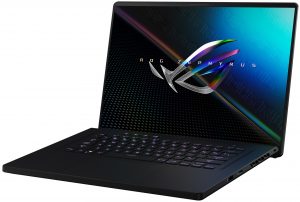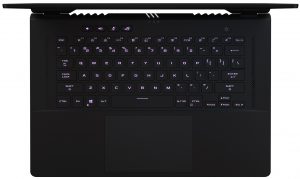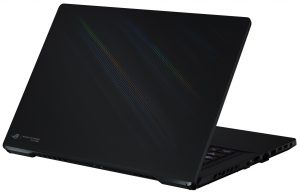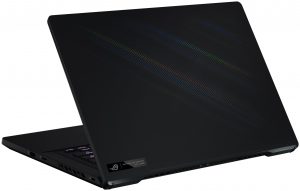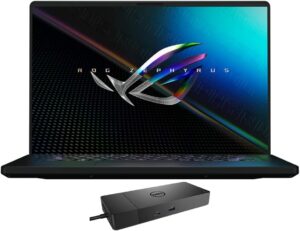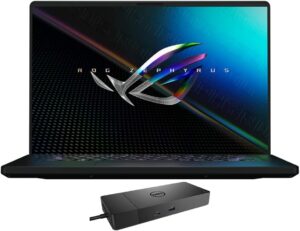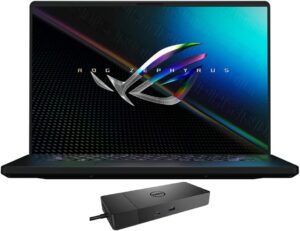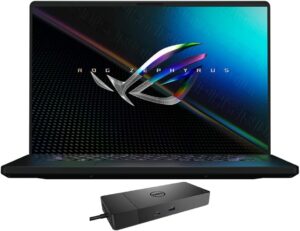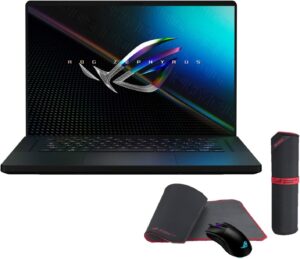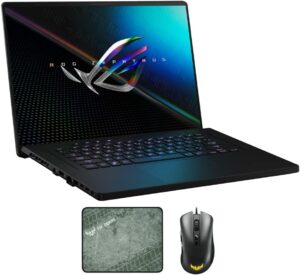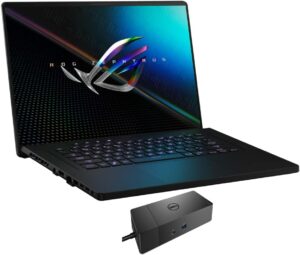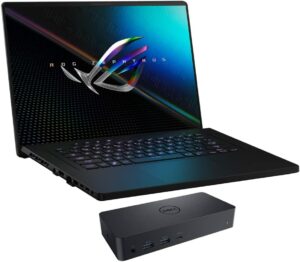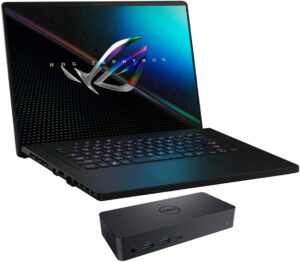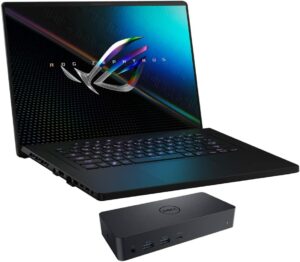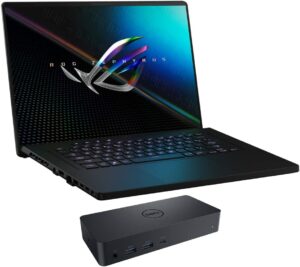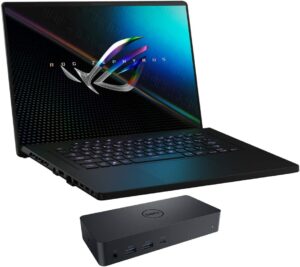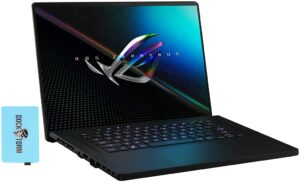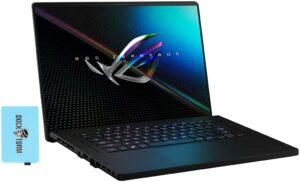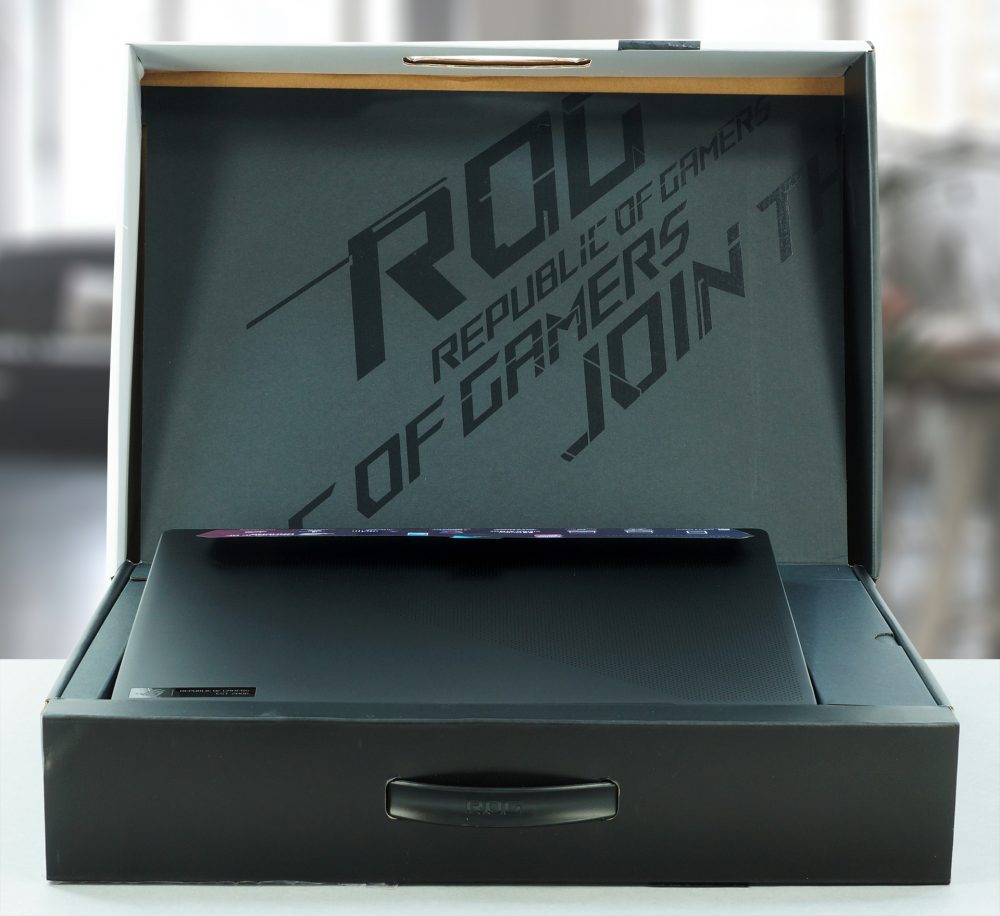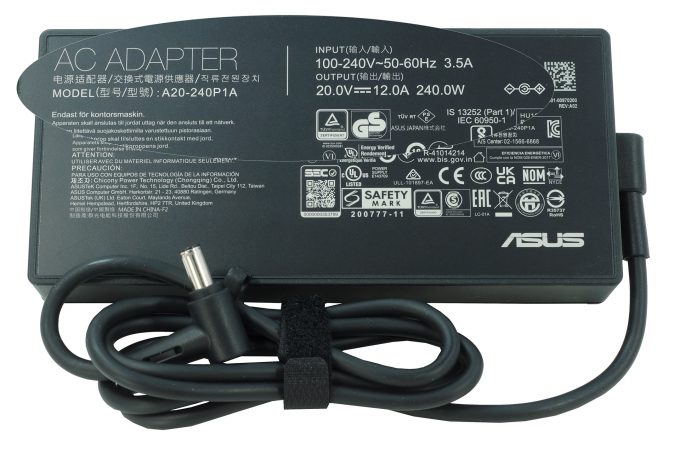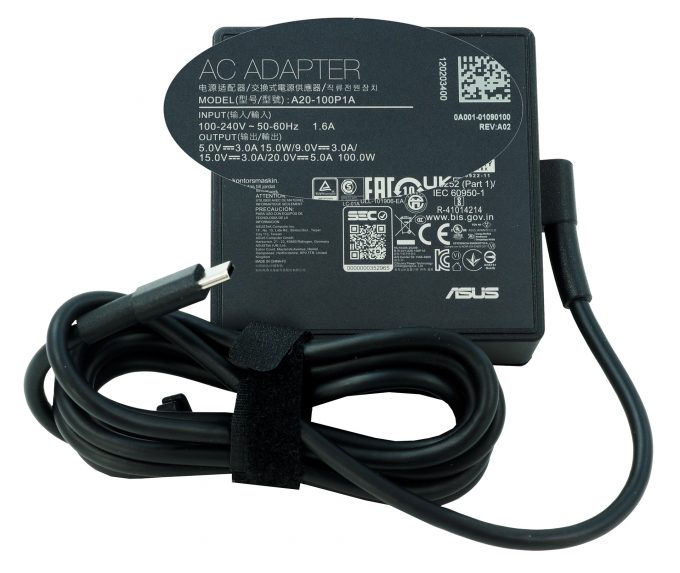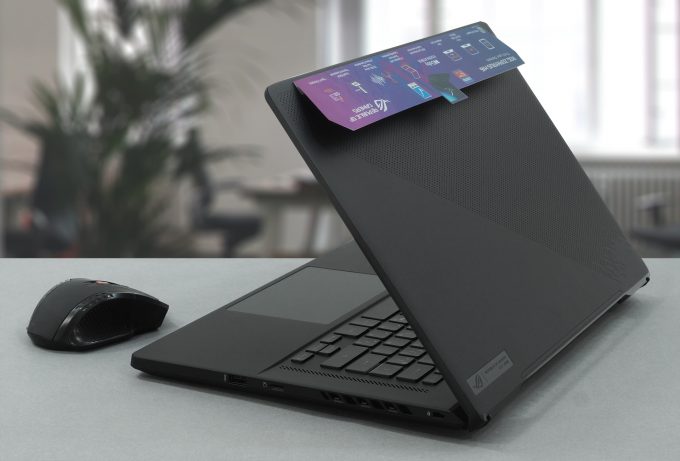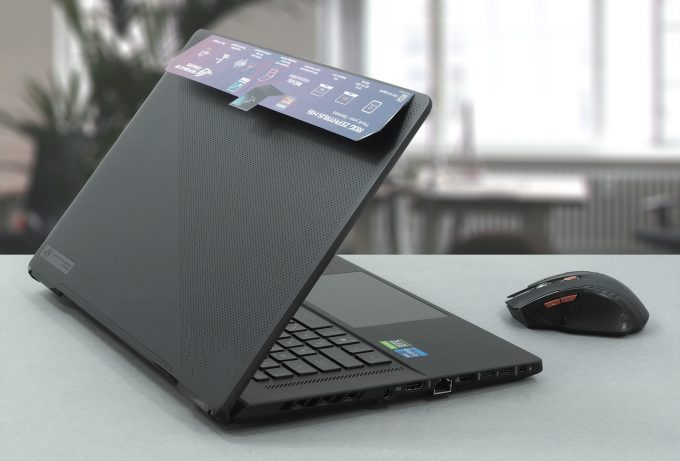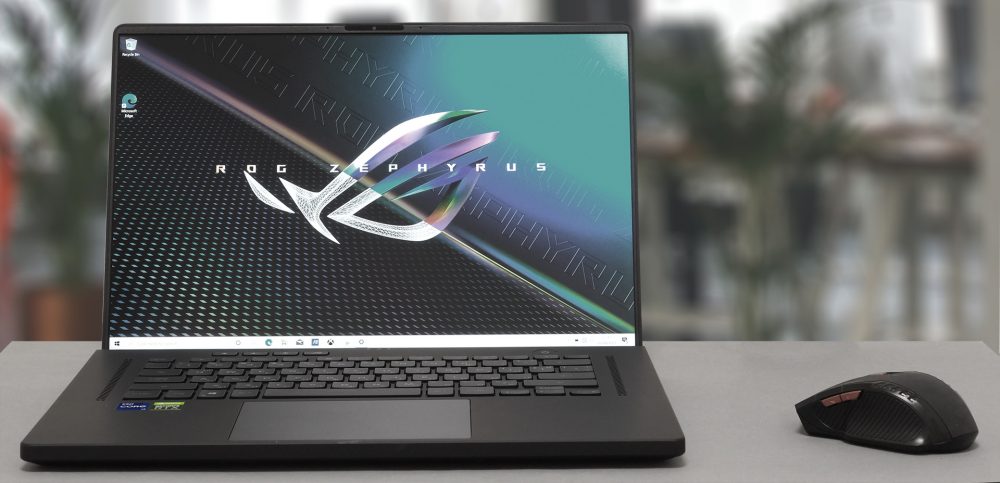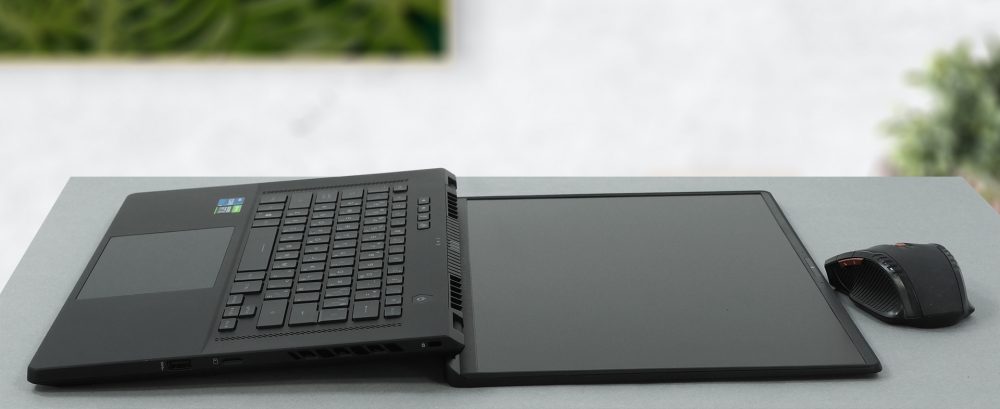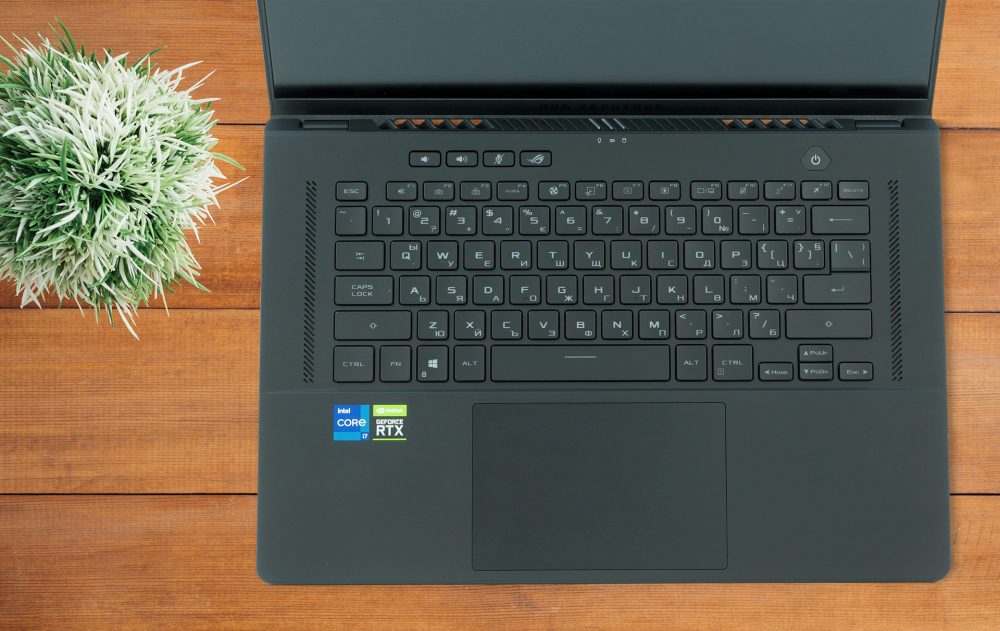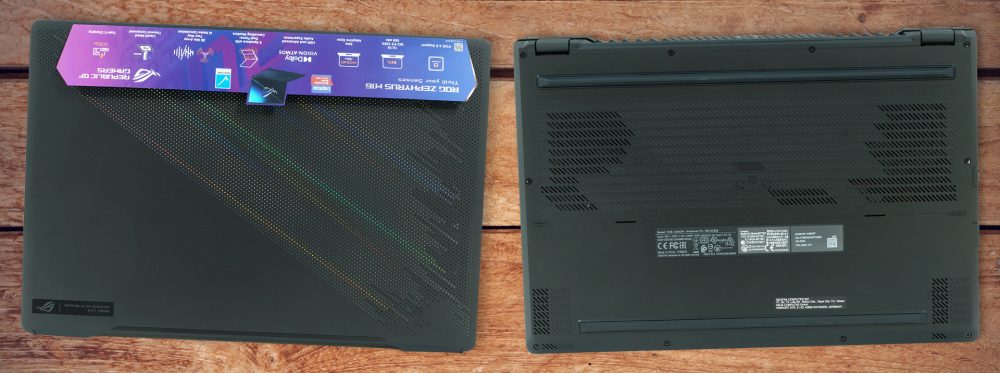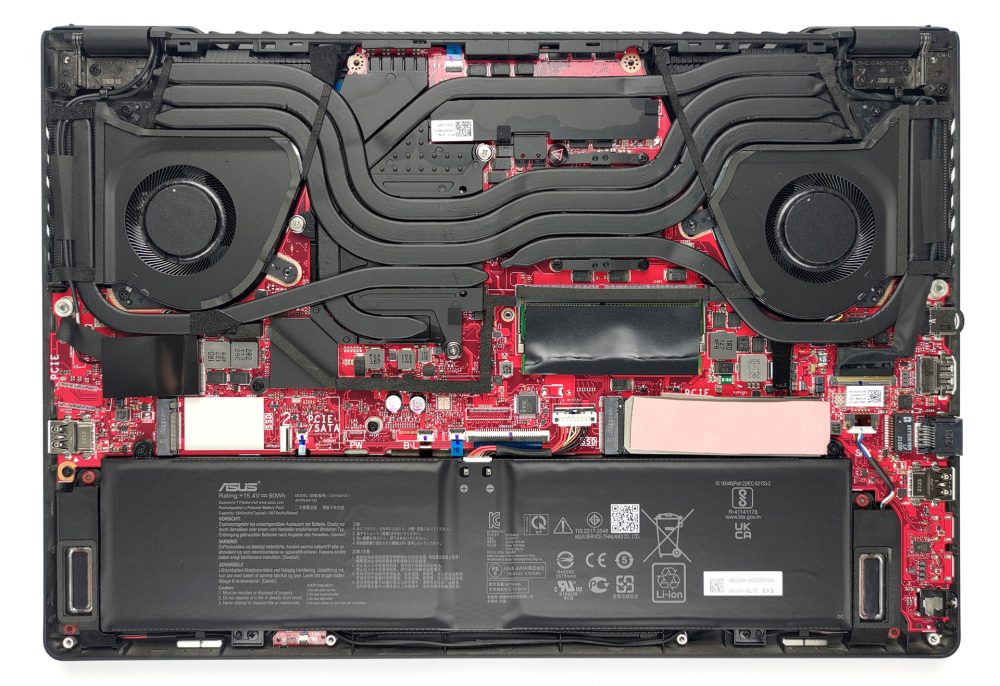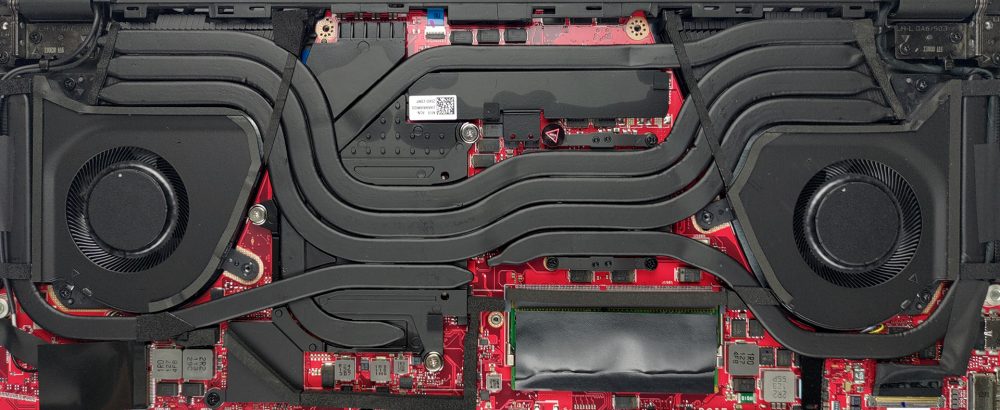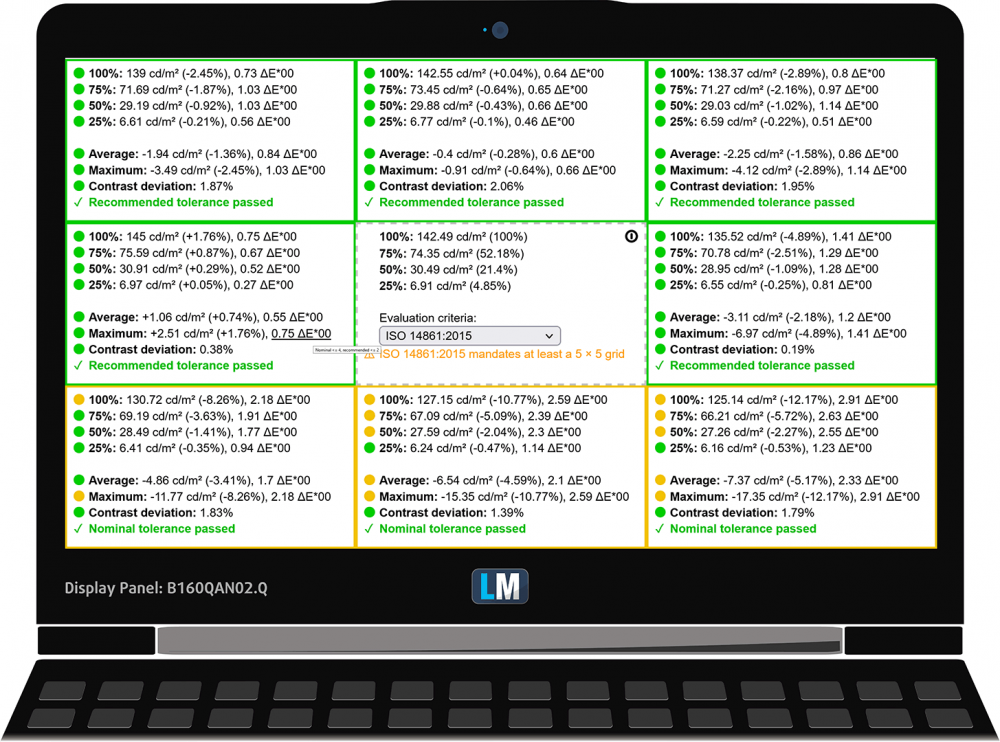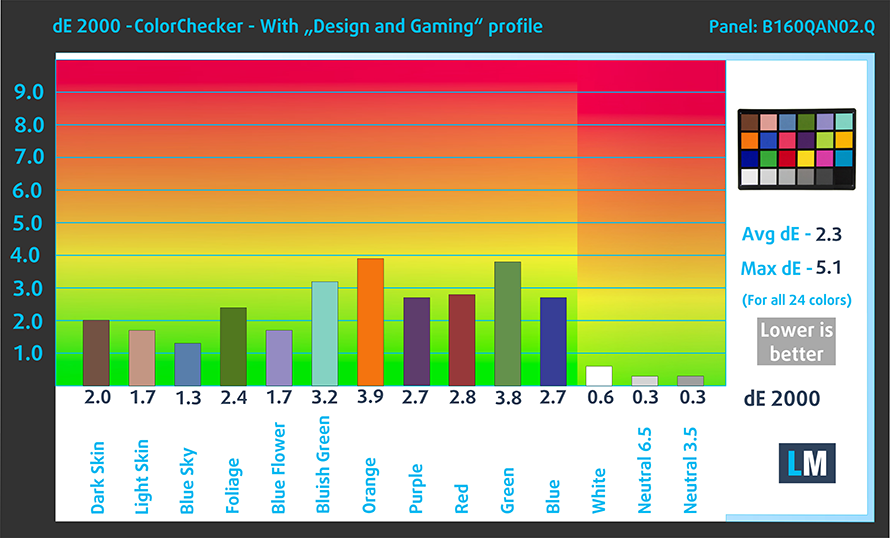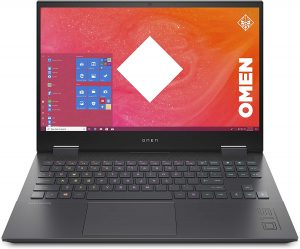ASUS ROG Zephyrus M16 GU603 review – great end result thanks to some tricks
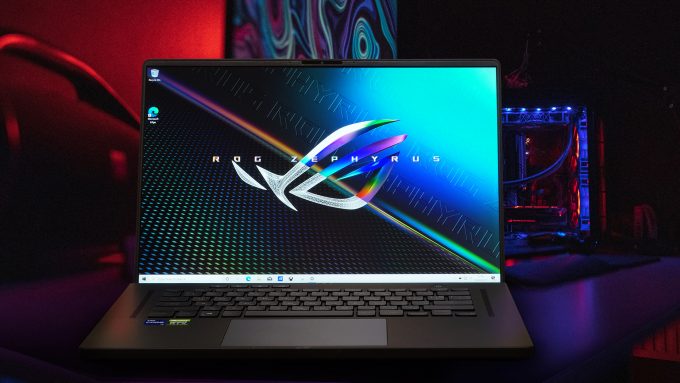 Following the success of the Zephyrus G15 GA503, ASUS was quick to release the 16-inch M16. Its name is a bit of a mouthful (ASUS ROG Zephyrus M16 GU603), but at the end of the day what matters is performance. And the manufacturer has clearly taken care of this.
Following the success of the Zephyrus G15 GA503, ASUS was quick to release the 16-inch M16. Its name is a bit of a mouthful (ASUS ROG Zephyrus M16 GU603), but at the end of the day what matters is performance. And the manufacturer has clearly taken care of this.
In terms of CPUs, you can choose between the brand new eight-core devices from Intel – the Core i7-11800H, and the Core i9-11900H. Surprisingly, these two are on the same level, if not better than the top dogs of AMD. But in order to extract the maximum of these CPUs, you need a good cooling system. And to aid that, ASUS uses liquid metal thermal compound for their processor. Actually, this is something common between most of the company’s gaming notebooks in 2021.
You have to keep in mind, that the Zephyrus M16 is far from being the most potent laptop in the ROG ecosystem. However, it aims to be the best overall package with a 16-inch QHD display, refreshing every 165th of a second. And to run all these pixels, you get up to an RTX 3070 with 100W of TGP (including Dynamic Boost).
So let’s see what is this laptop going to offer in the grand scheme of things.
You can check the prices and configurations in our Specs System: https://laptopmedia.com/series/asus-rog-zephyrus-m16-gu603/
Contents
Video Review
Specs Sheet
- HDD/SSD
- up to 16000GB SSD
- M.2 Slot
- 1x M.2 PCIe 4.0 x4 + 1x M.2 PCIe 3.0 x4 See photo
- RAM
- up to 40GB
- OS
- Windows 10 Home, Windows 11 Home, Windows 10 Pro, Windows 11 Pro
- Battery
- 90Wh, 4-cell
- Body material
- Plastic / Polycarbonate, Aluminum
- Dimensions
- 355 x 243 x 19.9 mm (13.98" x 9.57" x 0.78")
- Weight
- 1.90 kg (4.2 lbs)
- Ports and connectivity
- 1x USB Type-A
- 3.2 Gen 1 (5 Gbps)
- 1x USB Type-A
- 3.2 Gen 2 (10 Gbps)
- 1x USB Type-C
- 3.2 Gen 2 (10 Gbps), Power Delivery (PD), DisplayPort
- 1x USB Type-C
- Thunderbolt 4, Power Delivery (PD), DisplayPort
- HDMI
- 2.0b
- Card reader
- MicroSD
- Ethernet LAN
- Wi-Fi
- 802.11ax
- Bluetooth
- 5.2
- Audio jack
- 3.5mm Combo Jack
- Features
- Fingerprint reader
- Web camera
- HD
- Backlit keyboard
- Microphone
- Array Microphone with AI Noise Cancelling
- Speakers
- 2x 2W Tweeter + 4x 2W Woofer, Smart Amp, Dolby Atmos
- Optical drive
- Security Lock slot
- Kensington Lock
All ASUS ROG Zephyrus M16 GU603 configurations
What’s in the box?
Inside the package, you will find the mandatory paperwork, and not one, but two chargers. One of them is a 100W USB Type-C unit, which can be used as a travel adapter, if you have other accessories, using the Type-C connection. As for the other, it is a 240W unit, which should be your main power adapter.
Design and construction
As the 16-inch form factor gets more and more popular, we will see more devices coming with it. However, it is genuinely impressive how ASUS has managed to make a laptop of this size that weighs 1.90 kilos and has a profile of 19.9mm. Interestingly, the body feels pretty resilient, although there is some keyboard flex. Additionally, you can see from some of the images below that the back foot seems pretty large. This, combined with the ErgoLift technology, provides a lot of breathing space for the fans.
Ultimately, ASUS doesn’t specify the materials used for the build, but they are most likely plastic. Well, the lid is clearly metal, though. And it has the same prismatic film and dot array as the Zephyrus G15 GA503. Quite on the opposite, the ROG logo is placed in the bottom left corner, which reveals the serious intents of the company.
The lid opens easily with a single hand, and besides the ErgoLift mechanism, you can open the display as much as 180°. Thankfully, above the matte display (which covers 94% of the area) you can see an HD Web camera.
Moving to the keyboard we see something familiar. Unfortunately, the keycaps feel a bit small, but the key travel and the feedback seem good for both gaming and typing. Well, the Arrow keys are small, which is not great.
Interestingly, this is one of these gaming laptops that come with a fingerprint reader. It is embedded into the power button. As you can see, there are 4 dedicated buttons – three of them are for sound and mic control, while the last one opens the Armoury Crate tool. By the way, surrounding the keyboard are the two 2W tweeters.
Further down below you will see the enormous touchpad. It has a glass surface that feels super smooth and offers very accurate tracking. As far as the palm rest area goes, you will be met by a soft rubber-like finish.
And lastly, the bottom panel houses the ventilation grills, as well as the 2W woofers. Instead of two, however, there are four, placed in opposite directions to minimize vibrations. Respectively, the hot air is blown away from the inside through four grills – one on each side, and two on the back.
Ports
On the left side, you will find the charging plug, an HDMI 2.0b connector, an RJ-45 connector, a USB Type-A 3.2 (Gen. 2) port, a Thunderbolt 4 connector, a USB Type-C 3.2 (Gen. 2) port, and an audio jack. Then, on the right, there is a Kensington lock slot, a MicroSD card reader, and a USB Type-A 3.2 (Gen. 1) port.
Disassembly, upgrade options and maintenance
To get inside of this laptop, you need to undo 10 Phillips-head screws, as well as three more hidden beneath some rubber caps. After that, start the prying process from the corner, where the screw remains attached to the panel.
This device sports a 90Wh battery pack.
In addition to the 16GB soldered to the motherboard, you get one SODIMM slot for memory expansion. The maximum supported capacity is 48GB. This is not ideal but on the bright side, there are two M.2 slots. One of them supports both PCIe and SATA drives, while the other can fit PCIe x4 Gen 4 drives.
Here, the cooling solution comprises three heat pipes common between the CPU and the GPU. Additionally, you get one more for each of the chips, and a final 6th one for the VRMs and the graphics memory.
Display quality
ASUS ROG Zephyrus M16 GU603 in the configuration we tested has a 165Hz WQXGA panel – AUO B160QAN02.Q (AUOC199). Its diagonal is 16″ (40.6 cm), and the resolution is 2560 х 1600 pixels. The screen ratio is 16:10, and we are looking at a pixel density of – 189 ppi, and a pitch of 0.13 х 0.13 mm. The screen turns into Retina when viewed at distance equal to or greater than 46cm (18″) (from this distance one’s eye stops differentiating the separate pixels, and it is normal for looking at a laptop).
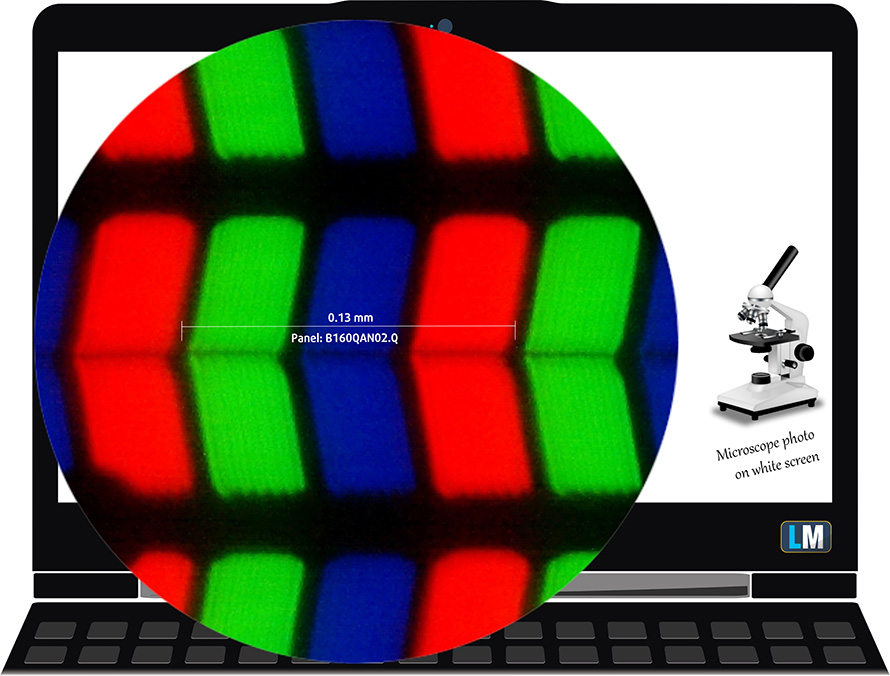
Viewing angles are excellent. We offer images at 45° to evaluate image quality.

Also, a video with locked focus and exposure.
We measured a maximum brightness of 510 nits in the middle of the screen and 488 nits as an average for the whole area, with a maximum deviation of 12%. The Correlated Color Temperature on a white screen is 6800K – slightly colder than the optimal for the sRGB standard of 6500K.
In the illustration below you can see how the main display performs from a uniformity perspective. In other words, the leakage of light from the light source.
Values of dE2000 over 4.0 should not occur, and this parameter is one of the first you should check if you intend to use the laptop for color-sensitive work. The contrast ratio is good – 1200:1.
To make sure we are on the same page, we would like to give you a little introduction to the sRGB color gamut and the Adobe RGB. To start, there’s the CIE 1976 Uniform Chromaticity Diagram that represents the visible specter of colors by the human eye, giving you a better perception of the color gamut coverage and the color accuracy.
Inside the black triangle, you will see the standard color gamut (sRGB) that is being used by millions of people on HDTV and on the web. As for the Adobe RGB, this is used in professional cameras, monitors, etc for printing. Basically, colors inside the black triangle are used by everyone and this is the essential part of the color quality and color accuracy of a mainstream notebook.
Still, we’ve included other color spaces like the famous DCI-P3 standard used by movie studios, as well as the digital UHD Rec.2020 standard. Rec.2020, however, is still a thing of the future and it’s difficult for today’s displays to cover that well. We’ve also included the so-called Michael Pointer gamut, or Pointer’s gamut, which represents the colors that naturally occur around us every day.
The yellow dotted line shows ASUS ROG Zephyrus M16 GU603’s color gamut coverage.
Its display is able to replicate the entire sRGB and DCI-P3 gamuts.
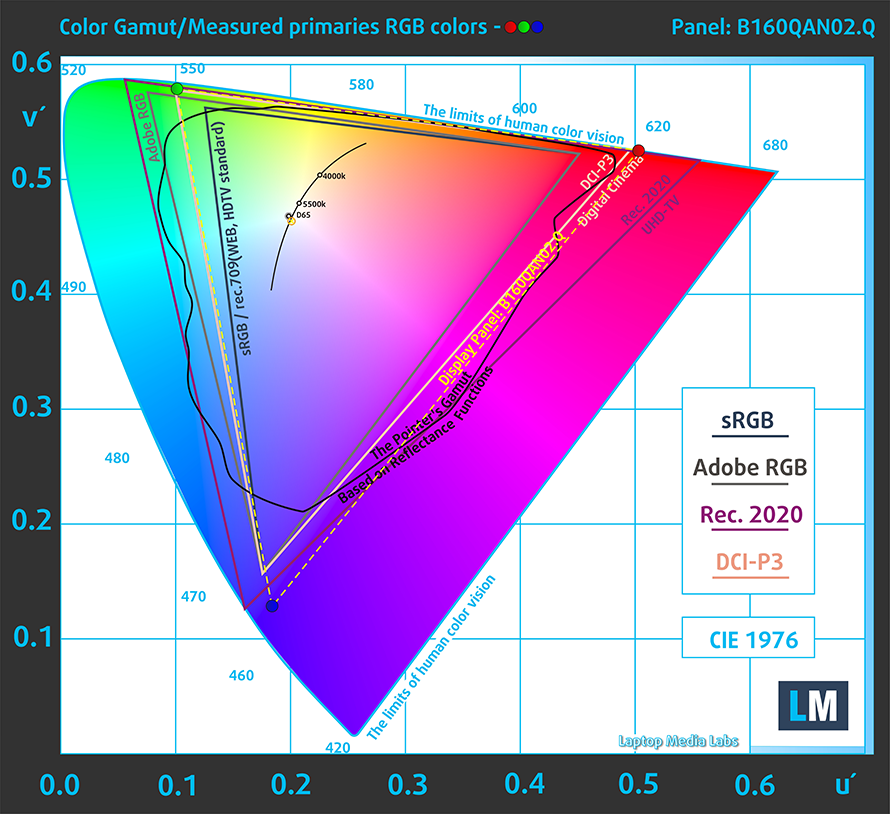
Our “Design and Gaming” profile delivers optimal color temperature (6500K) at 140 cd/m2 luminance and sRGB gamma mode.
We tested the accuracy of the display with 24 commonly used colors like light and dark human skin, blue sky, green grass, orange, etc. You can check out the results at factory condition and also, with the “Design and Gaming” profile.
The next figure shows how well the display is able to reproduce really dark parts of an image, which is essential when watching movies or playing games in low ambient light.
The left side of the image represents the display with stock settings, while the right one is with the “Gaming and Web Design” profile activated. On the horizontal axis, you will find the grayscale, and on the vertical axis – the luminance of the display. On the two graphs below you can easily check for yourself how your display handles the darkest nuances but keep in mind that this also depends on the settings of your current display, the calibration, the viewing angle, and the surrounding light conditions.
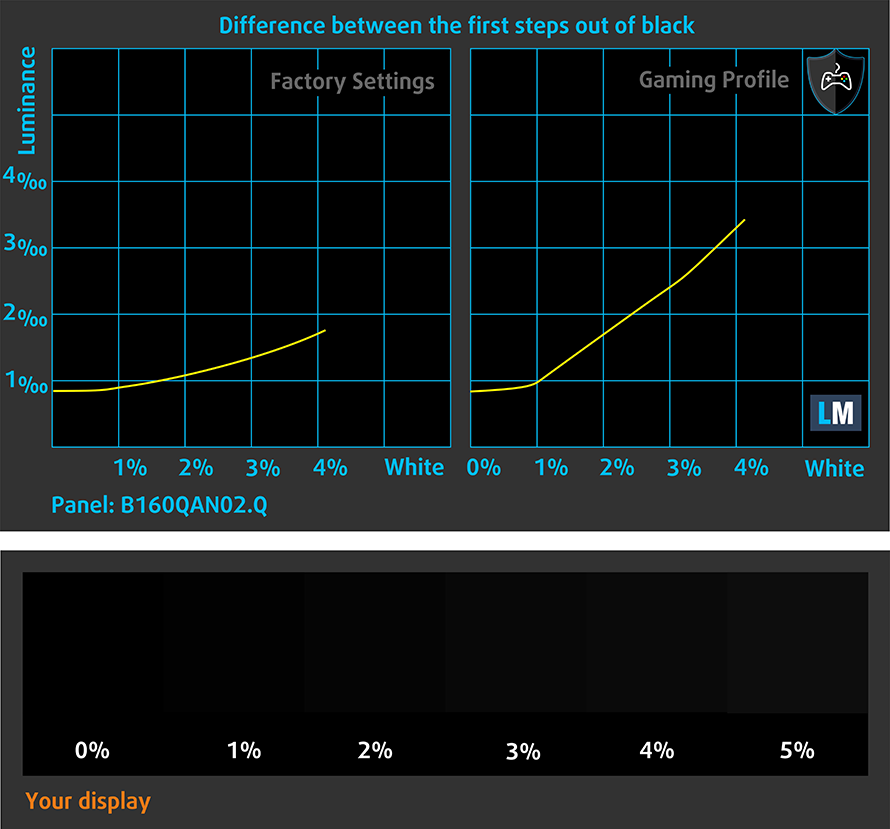
Response time (Gaming capabilities)
We test the reaction time of the pixels with the usual “black-to-white” and “white-to-black” method from 10% to 90% and vice versa.
We recorded Fall Time + Rise Time = 8 ms.
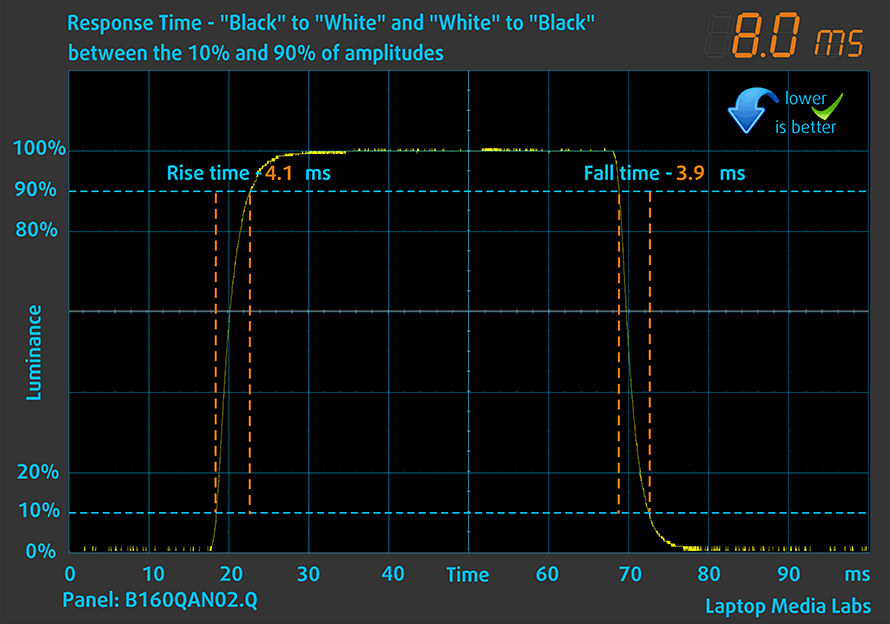
After that, we test the reaction time of the pixels with the usual “Gray-to-Gray” method from 50% White to 80% White and vice versa between 10% and 90% of the amplitude.

PWM (Screen flickering)
Pulse-width modulation (PWM) is an easy way to control monitor brightness. When you lower the brightness, the light intensity of the backlight is not lowered, but instead turned off and on by the electronics with a frequency indistinguishable to the human eye. In these light impulses, the light/no-light time ratio varies, while brightness remains unchanged, which is harmful to your eyes. You can read more about that in our dedicated article on PWM.
ASUS ROG Zephyrus M16 GU603’s display doesn’t use PWM to adjust its brightness at any point. This means it is comfortable for long gaming sessions without harming your eyes in this aspect.
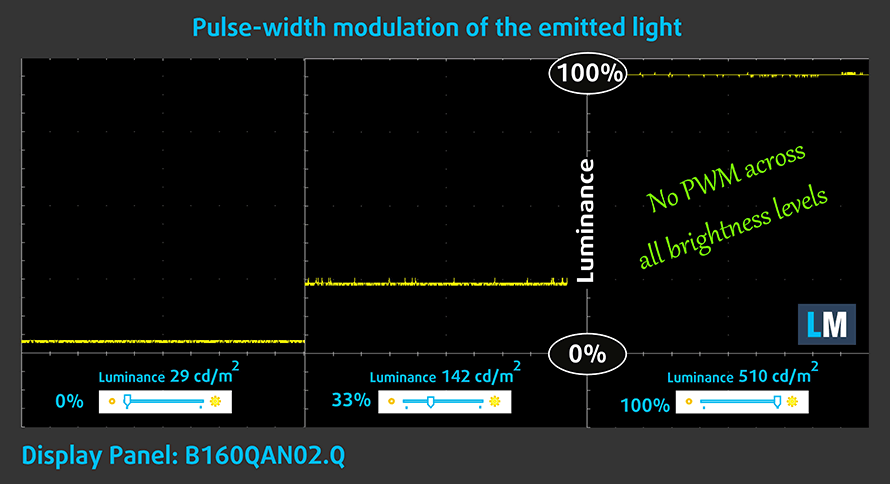
Blue light emissions
Installing our Health-Guard profile not only eliminates PWM but also reduces the harmful Blue Light emissions while keeping the colors of the screen perceptually accurate. If you’re not familiar with the Blue light, the TL;DR version is – emissions that negatively affect your eyes, skin, and your whole body. You can find more information about that in our dedicated article on Blue Light.
Buy our profiles
Since our profiles are tailored for each individual display model, this article and its respective profile package are meant for ASUS ROG Zephyrus M16 GU603 configurations with 16″ WQXGA IPS AUO B160QAN02.Q (AUOC199).
*Should you have problems with downloading the purchased file, try using a different browser to open the link you’ll receive via e-mail. If the download target is a .php file instead of an archive, change the file extension to .zip or contact us at [email protected].
Read more about the profiles HERE.
In addition to receiving efficient and health-friendly profiles, by buying LaptopMedia's products you also support the development of our labs, where we test devices in order to produce the most objective reviews possible.

Office Work
Office Work should be used mostly by users who spend most of the time looking at pieces of text, tables or just surfing. This profile aims to deliver better distinctness and clarity by keeping a flat gamma curve (2.20), native color temperature and perceptually accurate colors.

Design and Gaming
This profile is aimed at designers who work with colors professionally, and for games and movies as well. Design and Gaming takes display panels to their limits, making them as accurate as possible in the sRGB IEC61966-2-1 standard for Web and HDTV, at white point D65.

Health-Guard
Health-Guard eliminates the harmful Pulse-Width Modulation (PWM) and reduces the negative Blue Light which affects our eyes and body. Since it’s custom tailored for every panel, it manages to keep the colors perceptually accurate. Health-Guard simulates paper so the pressure on the eyes is greatly reduced.
Get all 3 profiles with 33% discount
Sound
ASUS ROG Zephyrus M16 GU603’s six-speaker setup produces a dynamic sound with very good quality. Furthermore, its low, mid, and high tones are clear of deviations.
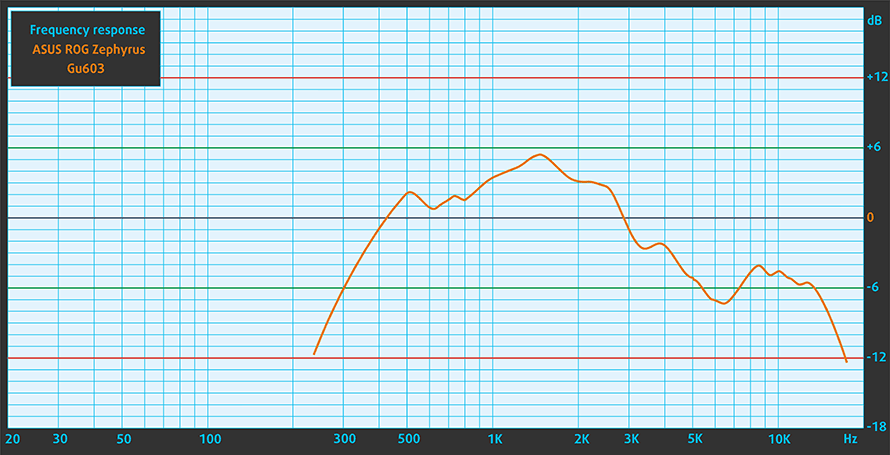
Drivers
All of the drivers and utilities for this notebook can be found here: https://rog.asus.com/laptops/rog-zephyrus/2021-rog-zephyrus-m16-series/helpdesk_download
Battery
Now, we conduct the battery tests with Windows Better performance setting turned on, screen brightness adjusted to 120 nits, and all other programs turned off except for the one we are testing the notebook with. This notebook’s 90Wh battery pack lasts for 13 hours and 3 minutes of Web browsing, and 8 hours of video playback.
In order to simulate real-life conditions, we used our own script for automatic web browsing through over 70 websites.
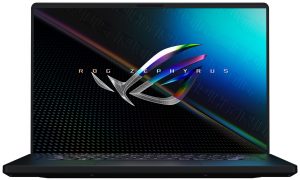
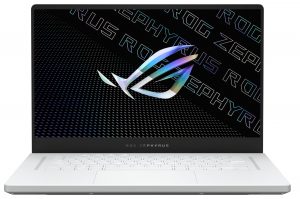
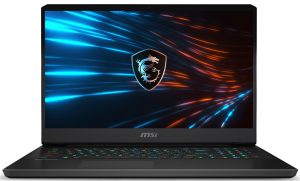
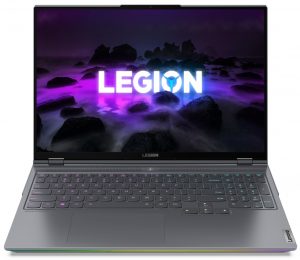
For every test like this, we use the same video in HD.




CPU options
Currently, this device can be purchased with the Core i7-11800H or the Core i9-11900H.
Results are from the Cinebench R23 CPU test (the higher the score, the better)
Results are from our Photoshop benchmark test (the lower the score, the better)
GPU options
As for the graphics, you get the GeForce RTX 3050 Ti (75W), RTX 3060 (95W), or RTX 3070 (100W).
Results are from the 3DMark: Time Spy (Graphics) benchmark (higher the score, the better)
Results are from the 3DMark: Fire Strike (Graphics) benchmark (higher the score, the better)
Results are from the Unigine Superposition benchmark (higher the score, the better)
Gaming tests

| Far Cry 5 | Full HD, Normal (Check settings) | Full HD, High (Check settings) | Full HD, Ultra (Check settings) |
|---|---|---|---|
| Average | 123 fps | 113 fps | 108 fps |

| Rise of the Tomb Raider (2016) | Full HD, Medium (Check settings) | Full HD, Very High (Check settings) | Full HD, MAX (Check settings) |
|---|---|---|---|
| Average | 132 fps | 98 fps | 69 fps |

| Tom Clancy’s Ghost Recon Wildlands | Full HD, High (Check settings) | Full HD, Very High (Check settings) | Full HD, Ultra (Check settings) |
|---|---|---|---|
| Average | 108 fps | 95 fps | 65 fps |

| Shadow of the Tomb Raider (2018) | Full HD, Medium (Check settings) | Full HD, High (Check settings) | Full HD, Highest (Check settings) |
|---|---|---|---|
| Average | 100 fps | 94 fps | 78 fps |
Temperatures and comfort
Max CPU load
In this test we use 100% on the CPU cores, monitoring their frequencies and chip temperature. The first column shows a computer’s reaction to a short load (2-10 seconds), the second column simulates a serious task (between 15 and 30 seconds), and the third column is a good indicator of how good the laptop is for long loads such as video rendering.
Average core frequency (base frequency + X); CPU temp.
| Intel Core i7-11800H (45W TDP) | 0:02 – 0:10 sec | 0:15 – 0:30 sec | 10:00 – 15:00 min | Max Fans |
|---|---|---|---|---|
| ASUS ROG Zephyrus M16 GU603 | 3.87 GHz (B+68%) @ 95°C @ 106W | 3.90 GHz (B+70%) @ 95°C @ 109W | 3.58 GHz (B+56%) @ 86°C @ 80W | – |
| MSI Creator Z16 (A11Ux) | 3.12 GHz (B+36%) @ 96°C @ 68W | 3.03 GHz (B+32%) @ 95°C @ 62W | 2.76 GHz (B+20%) @ 95°C @ 53W | 2.90 GHz (B+26%) @ 95°C @ 59W |
| MSI GE76 Raider (2021) | 3.22 GHz (B+40%) @ 95°C @ 67W | 3.11 GHz (B+35%) @ 94°C @ 62W | 3.14 GHz (B+37%) @ 94°C @ 61W | 3.26 GHz (B+42%) @ 94°C @ 64W |
| ASUS TUF F15 (FX506, 2021) (Turbo Mode) | 3.98 GHz (B+73%) @ 86°C @ 102W | 3.88 GHz (B+69%) @ 95°C @ 100W | 3.44 GHz (B+50%) @ 87°C @ 77W | – |
| MSI Pulse GL76 | 3.16 GHz (B+37%) @ 95°C @ 65W | 3.00 GHz (B+30%) @ 95°C @ 59W | 2.87 GHz (B+25%) @ 95°C @ 55W | – |
| MSI Pulse GL66 | 2.94 GHz (B+28%) @ 94°C @ 58W | 2.76 GHz (B+20%) @ 94°C @ 52W | 2.77 GHz (B+20%) @ 94°C @ 52W | – |
Evidently, the liquid metal thermal compound does its job. This is the best result from a Core i7-11800H-equipped laptop thus far.
Real-life gaming
| NVIDIA GeForce RTX 3070 | GPU frequency/ Core temp (after 2 min) | GPU frequency/ Core temp (after 30 min) |
|---|---|---|
| ASUS ROG Zephyrus M16 GU603 | 1545 MHz @ 75°C @ 100W | 1520 MHz @ 81°C @ 100W |
| HP Omen 15 (2021, 15-en1000) | 1285 MHz @ 70°C @ 80W | 1288 MHz @ 70°C @ 80W |
| ASUS ROG Zephyrus Duo 15 SE (GX551) | 1689 MHz @ 71°C @ 131W | 1676 MHz @ 72°C @ 129W |
| ASUS ROG Strix G17 G713 | 1649 MHz @ 83°C @ 130W | 1646 MHz @ 84°C @ 130W |
| ASUS TUF A17 (FA706) 2021 | 1440 MHz @ 74°C @ 95W | 1465 MHz @ 77°C @ 95W |
| ASUS TUF Dash F15 (FX516) | 1389 MHz @ 69°C @ 84W | 1377 MHz @ 74°C @ 84W |
Although the temperature after 30 minutes of gaming seemed a bit too high, we are satisfied with the frequency readings, considering the 100W TGP limit of the RTX 3070.
Gaming comfort
The good news is that the WASD area remains cool even after long gaming sessions. Unfortunately, the hottest point on the keyboard reached above 50°C. Also, the device was pretty loud too.
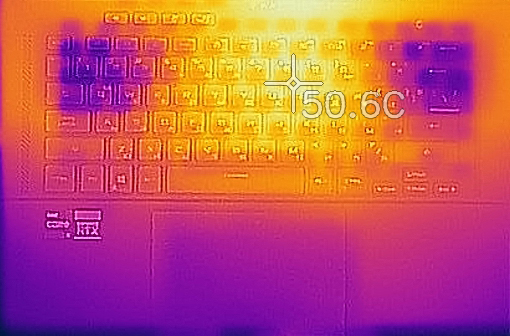
Verdict
 Let’s start with our summary with the more obvious stuff. First of all, the design looks stunning. The laptop is decently built and has good input devices. Its battery can last for 13 hours of Web browsing, and 8 hours of video playback. Of course, if you add a heavy-duty load, the juice will drain as soon as a lake with a cracked dam.
Let’s start with our summary with the more obvious stuff. First of all, the design looks stunning. The laptop is decently built and has good input devices. Its battery can last for 13 hours of Web browsing, and 8 hours of video playback. Of course, if you add a heavy-duty load, the juice will drain as soon as a lake with a cracked dam.
Nevertheless, we are all here for the performance. Well, especially regarding the computational power, this is the fastest laptop with a Core i7-11800H. This is due to the ton of heat pipes, as well as the liquid metal beneath them and the CPU die.
ASUS ROG Zephyrus M16 GU603’s 165Hz IPS panel has a high resolution, comfortable viewing angles, and a good contrast ratio. Moreover, its backlight doesn’t use PWM, and it covers both the sRGB and DCI-P3 gamuts almost fully. Thankfully, the high-refresh-rate panel is paired with quick pixel response times, which results in a super-smooth gaming experience.
Let’s not forget to mention the fingerprint reader, the HD Web camera, a Thunderbolt 4 connector, a MicroSD card slot. In addition to that, you get two M.2 slots, one of which supports Gen 4 drives. Unfortunately, 16GB of the memory is soldered to the motherboard. This doesn’t mean you won’t be able to upgrade it in the future, but the maximum is 48GB, compared to 64 in the majority of gaming laptops.
So, considering the fact that ASUS has put great hardware inside of this notebook. However, the GPU cooling seems to be lacking a bit. And the bigger problem is actually, the insulation between the keyboard and the motherboard. This results in a super high temperature in the middle of the keyboard.
Other honorable mentions here must be the 6*2W speaker setup. Nevertheless, there is one thing that you must know at the end of the day. The prime work scenario of this machine should be content creation. You just can’t let that processor go. It is extremely quick, beats most of the mobile Ryzens of the world, and you get an astonishing display to work on.
You can check the prices and configurations in our Specs System: https://laptopmedia.com/series/asus-rog-zephyrus-m16-gu603/
Pros
- Fingerprint reader, Wi-Fi 6 support
- Up to 48GB of RAM
- Dual NVMe drive support
- PWM-free display (QHD, 165Hz panel)
- Quick pixel response times (QHD, 165Hz panel)
- 100% sRGB coverage + almost full DCI-P3 coverage and great color accuracy thanks to our Gaming and Web design profile (QHD, 165Hz panel)
- Extremely powerful CPU and GPU performance
Cons
- The middle of the keyboard gets pretty warm during gaming
- The keyboard has tiny arrow keys
- No NumberPad
